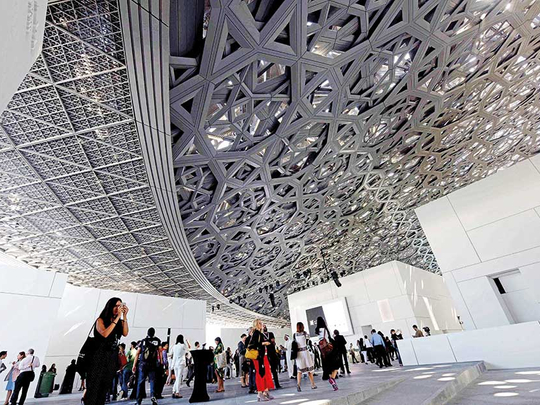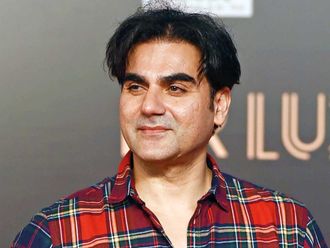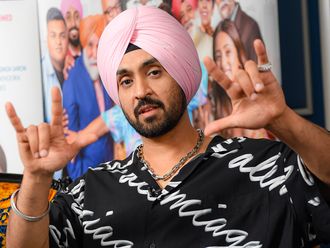
Abu Dhabi: Inside a gleaming glass case, three ewers stand side by side. All trimmed with gold, the casual visitor might think they are sourced from the same culture. Yet, a look at the information board reveals one is from China, the other from India, and the third from Turkey.
In another gallery with 13th and 14th century displays, a copy of the first part of the Jewish book, the Torah, is encased next to a Gothic Bible, some pages from the Blue Quran, as well as a Buddhist text and a Jain text.
This shared nature of human development is a theme echoed throughout the Louvre Abu Dhabi, which is set to open its doors on November 11. The museum is the result of an intergovernmental agreement between the UAE and France. On Tuesday, members of the media were allowed into the museum for the first look.
Speaking to mediapersons, Mohammad Al Mubarak, chairman of the Abu Dhabi Department of Culture and Tourism and the Tourism Development and Investment Company, said, “The Louvre Abu Dhabi is not just a museum.
“It will be a hub for education, and for broadcasting international tolerance and world culture. And future generations will be better off because of places like the Louvre Abu Dhabi.”
Jean Luc-Martinez, president-director of the Louvre Museum in Paris, also emphasised that the Louvre Abu Dhabi is an Emirati museum.
Related: A walk through the galleries
“It is an Emirati museum, a place to see the world from Abu Dhabi, and we have only transferred our knowledge over the last 10 years,” he said.
Walking into the facility, one cannot miss the ‘rain of light’ effect created by the iconic white dome. The nearly 50-tonne structure features a geometric design that allows sunlight to penetrate in specific angles through its eight layers. These rays then dance upon the white walls of the museum’s central area, creating an effect its architect, the award-winning Jean Nouvel from France, calls ‘rain of light’.
“I am a contextual architect, and I wanted to anchor this structure in its roots. I wanted it to reflect the sense of living in a traditional walled Arab city, with narrow streets and palm frond dwellings,” Nouvel said.
The structure, which is divided into 55 small white buildings, lends to an air of tranquillity that is only heightened by the interaction of the building with the blue seawaters that flood the outer corridors. Al Mubarak said the ambience takes him back to living in an Emirati oasis with palm frond dwellings.
The 12 galleries lead off from the central domed area, with 300 loaned artworks and artefacts displayed alongside items from the Louvre Abu Dhabi’s 620-piece permanent collection.
Speaking about the curatorial process, Jean-Francois Charnier, scientific director at the Louvre Abu Dhabi and the Agence France Museums, told Gulf News that the idea was to tell the story of humankind in the way that the pieces were acquired and arranged.
“For example, we had a portrait of Napolean Bonaparte on loan, and we spent two years looking for an appropriate companion to it, finally settling on a portrait of George Washington,” he said.
“We wanted the pieces to be meaningful to this culture, and also create a dialogue with the items around them. And it is obvious, as we go through the galleries, that humanity had periods of evolution that reverberated across cultures,” Charnier explained.
Art and culture enthusiasts will especially enjoy a visit to the new museum, as the loaned pieces currently include Italian master Leonardo da Vinci’s La Belle Ferronniere, Vincent Van Gogh’s Self-Portrait, and the portrait titled Whistler’s Mother by British painter James McNeill Whistler. These pieces are on loan from 15 French institutions, like the Louvre Museum in Paris and the Orsay Museum, for a decade.
The intergovernmental agreement with France also loans the name of the Louvre for 30 years and six months for a sum of $525 million (Dh1.92 billion), and gives the Abu Dhabi museum access to temporary exhibitions for 15 years.
The new museum, with its 97,000 square metres on built-up area that includes 8,600 square metres of galleries, is expected to be visited by French president Emmanuel Macron and UAE dignitaries on Wednesday. It will open its doors to the public at 10am on Saturday.












